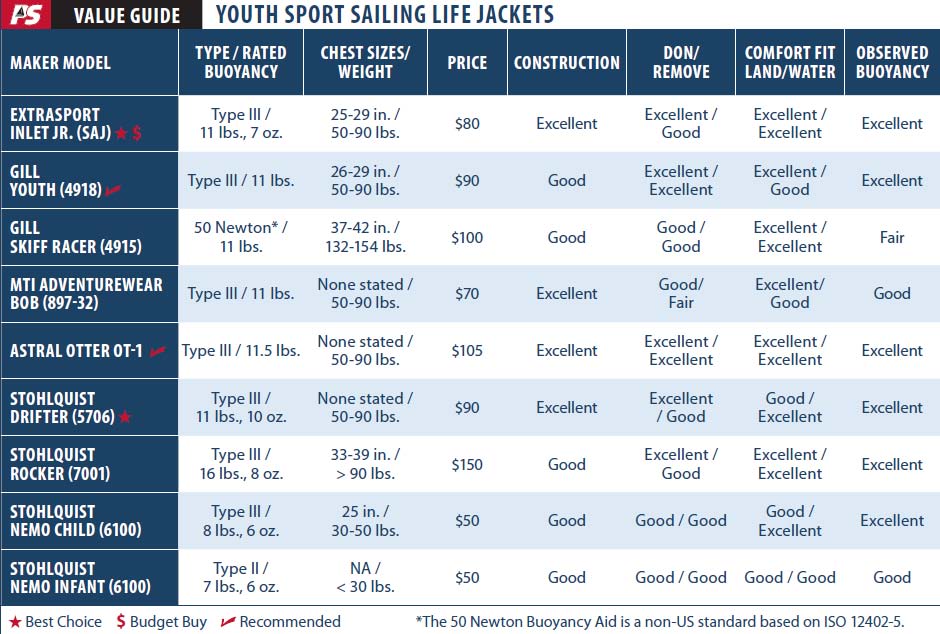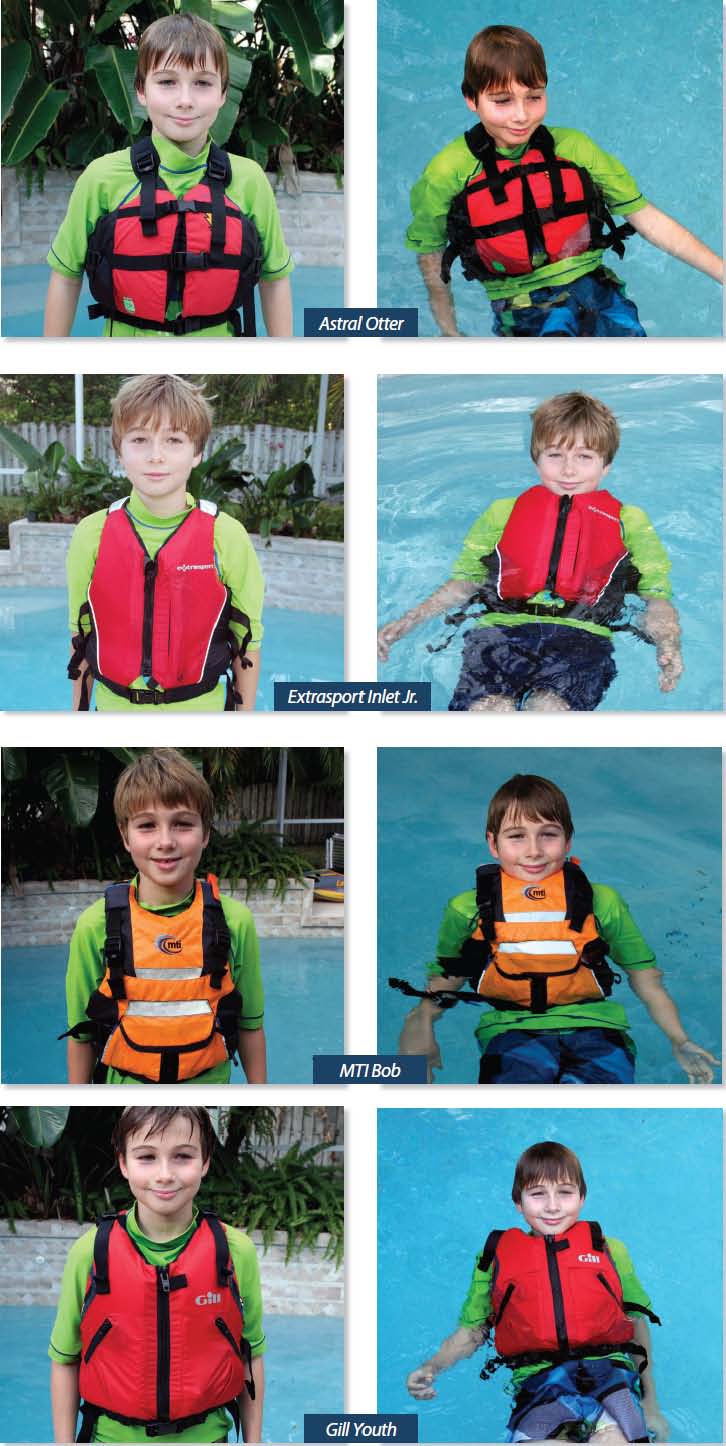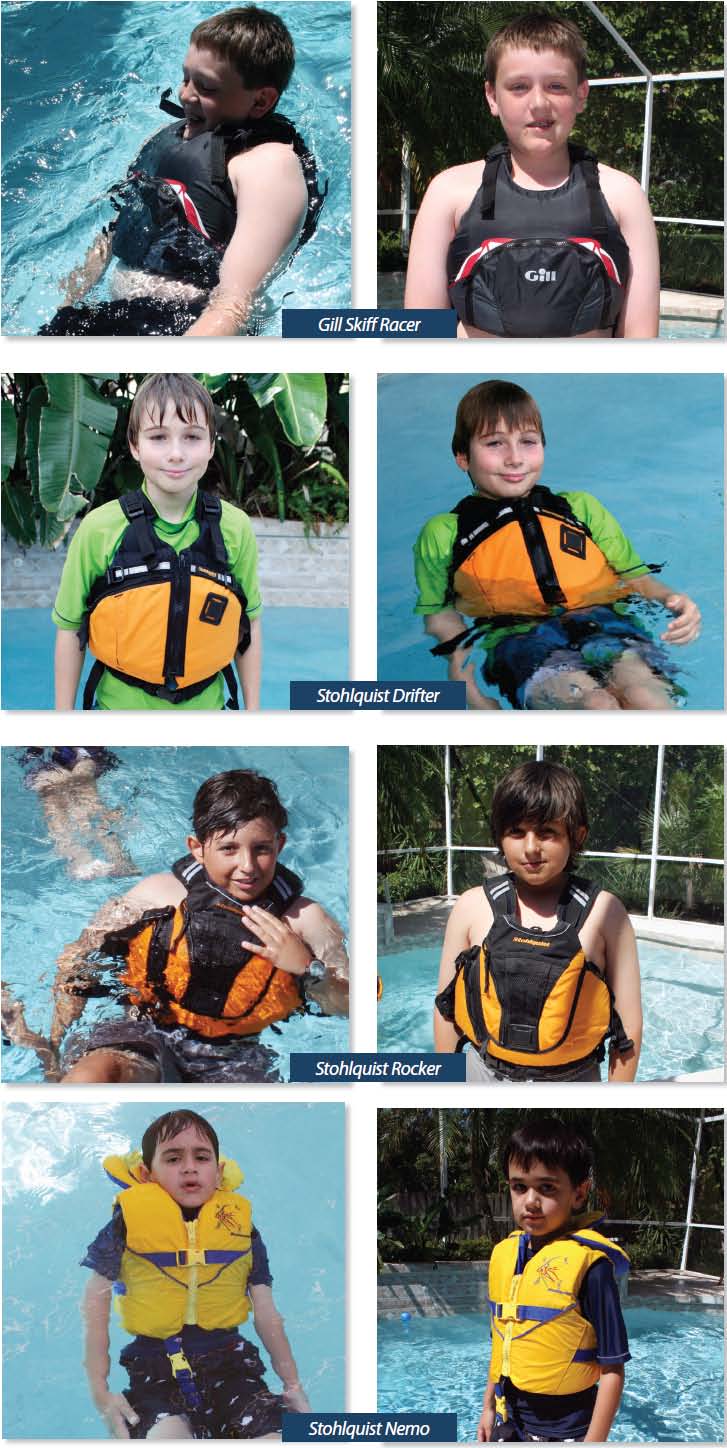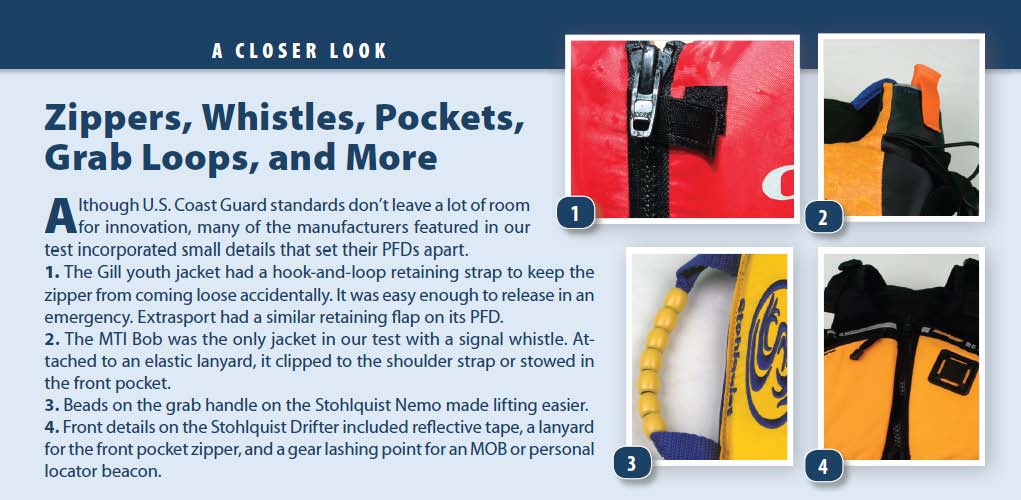With the hopes of sparing parents the hassle of sifting through all the varieties of youth life jackets on the market today, weve narrowed down the choices for children aged 7 to 12, roughly.
Six years ago, when we last looked at personal flotation devices (PFDs) for children weighing between 50 and 90 pounds (PS, July 2007), our three favorites were generally better suited for the cruising kid than the super-active Optimist sailor. Our top picks were a Type I jacket from Stearns (model 3630), a Type II jacket from Mustang (MV3160), and a hybrid jacket from Sospenders (12AYH). These were jackets with plenty of buoyancy and collars designed to keep an unconscious wearers head above the water.
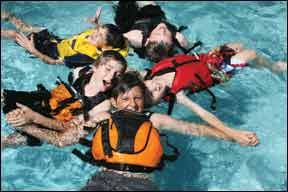
This time, we focused on Type III PFDs specifically aimed at active sailing or other watersports. We still believe a flotation collar like that found in our 2007 favorite, the Mustang 3160, is an important feature for younger boaters, but for active sailing, they are too cumbersome. And then theres the cool factor.
These kids are very style conscious, explained Aaron Freeman, a customer service representative at Annapolis Performance Sailing, a major East Coast supplier of sailing apparel and gear. They notice the jackets that the older kids are wearing-and what their instructors are wearing-and thats what they want. They don’t want cartoon figures or bulky collars on their jackets.
What We Tested
For this test, we rounded up six high-performance, U.S. Coast Guard certified Type III personal flotation devices (PFDs) from five manufacturers: Astral Designs, a group of paddlers, designers, engineers, and regular good people based in Asheville, N.C.; Extrasport, a division of Wisconsin-based Johnson Outdoors; Gill, a United Kingdom-based company that has cornered a large share of the U.S. market in sailing apparel; MTI Adventurewear, a Massachusetts-based company that specializes in PFDs; and Stohlquist, a Washington-based company that has focused on life jackets for paddlers for more than 30 years. Under the Coast Guard standards, a Type III PFD is merely a flotation aid. Unlike a Type I or Type II PFD, they are not designed to help right a face-down wearer or to keep an unconscious persons head above water. They merely help the wearer hold a stable face up position in calm water.
The Gill and Extrasport jackets are marketed principally to youth sailors; the others are also designed with kayaking and other paddlesports in mind. The kayaking-style jackets are generally higher cut, so that they don’t interfere with kayak skirts. They also allow for greater freedom of movement in the arm openings.
For comparison purposes, we also included an example of a swimming aid that meets foreign standards for flotation devices and is permitted in many international races, but has yet to attain U.S. Coast Guard approval. Also for comparison, we included one adult size-small jacket, suitable for a big 12-year-old, a small PFD for children under 50 pounds, and a new Type II toddler jacket. We will be following up with a look at the latest in adult PFDs in a future issue.
How We Tested
Two PS editors rated and reviewed the youth PFDs with the help of five children, all boys, who fit the weight and chest profile of the youth vests (50 to 90 pounds), and two children for each of the other PFDs. Each youth life jacket was donned by at least three boys. Testers checked how easy it was for the child to put on the vest by himself, or whether adult help was needed. Vests were evaluated for ease of donning and removal on land, ease of escape in the water, and comfort and fit both in and out of the water.
In-water testing was done in a swimming pool. Each child jumped in with a vest on and gave comments about the fit and comfort while swimming and floating on his back. Editors also observed the fit and buoyancy of the vest in the water and checked for slippage when using the shoulder straps to lift the child. Additionally, each child attempted to swim both on his stomach, on his back, and to dive underwater. None of the testers were able to dive more than a few inches below the surface, indicating the importance of easy removal in the case of a capsize. Vest ratings, buoyancy, and price helped determined the top picks.
Astral Otter
The Astral Otter is a good example of a kayaking-style vest. It is cut high in the back, has extra-large arm holes and flotation concentrated in the chest. Flotation is 11.5 pounds, and it floated the child testers as high as the Stohlquist Drifter, which has a rated buoyancy of 11 pounds, 10 ounces, the most of all the youth PFDs we tested.
A unique feature of the Astral is the organic filler, kapok, used in its two front sections. A fiber from the seeds of the tropical ceiba tree, kapok was a favorite life jacket filler for the U.S. Navy through both world wars. The downside of kapok is that if the sealed pouch containing the fibers is punctured, the bundle can absorb water, which reduces its flotation.
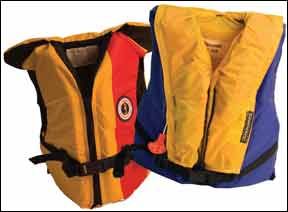
The Otter has a unique overlapping midriff belt, along with contoured padding in the front and rear panels, which provide a snug fit that prevents the jacket from riding up. The tapered, neoprene-padded shoulder straps were comfortable.
The Otter has no pockets or zippers. It is secured with two front clips, which made it the easiest to don and escape. A thin strip of reflective piping runs across the back. Its rugged 500-dernier Cordura material resists abrasion, and the interior is smooth, comfortable nylon. It comes in red or blue.
Bottom line: A zipper-free PFD for active sports enthusiasts, the Astral Otter was one of the most comfortable in our test. Its Recommended for those who prefer using renewable resources.
Extrasport Inlet Jr.
Many of the kids in the competitive sailing program near our home office in Sarasota, Fla., prefer Extrasport life jackets for their comfort. The parents said they like the price, which we found to be about $15-$20 cheaper (at Landfall Navigation) than other jackets in this class. In our opinion, the jackets appeal goes far beyond comfort and price.
The flotation foam is skived (a trade word for paring or shaping foam) and beveled to form-fit the childs body, so fit was exceptional on our testers, and donning was easy. The Inlet had plenty of reflective material high on the shoulder straps. It has a loop for a whistle lanyard or other gear. The waist clip is easy to locate and release.
With few exposed buckles, this was the most snag-free jacket in our test. The main zipper is recessed and has a protective flap that keeps the jacket from unzipping. The zipper for the self-draining slash pocket is tucked out of the way. The shoulder straps are non-adjustable, but they fit well on all of our testers. It is available in pink or red.
Bottom line: Price, fit, and features make this jacket an outstanding choice for the competitive racer. It is our Best Choice for active sailors as well as our Budget Buy overall.
Gill Youth
Rather than undergo the hassle of jumping through all the U.S. Coast Guard hoops, foreign companies often license an already-approved design under their brand. Gill recently took the harder road-a frustrating three-year effort to navigate the U.S. bureaucracy and introduce a new youth PFD to the U.S. market. The result is an easily adjustable nylon PFD that will fit most kids in the 50- to 90-pound range. There is also a childs version with a crotch strap fitting chest sizes 20 to 25 inches.
The two foam panels (front and back) were not noticeably beveled or contoured for fit. The back had reflective piping, but there is none on the front. Its armholes allowed for plenty of freedom of movement. Neoprene helped pad the shoulders. Two easily adjusted torso straps and a waist strap prevented it from riding up. This was the go-to jacket for a couple of our testers who liked the flak-jacket-type styling. It was one of the fastest-drying jackets in this size. It compares closely with the Extrasport jacket, with the main difference being the adjustable shoulder straps. It is available in red or black. We do not recommend black or other dark colors for PFDs.
Bottom line: Comfortable both in and out of the water, this is a well-made jacket that will appeal to brand-conscious sailors who already have a seabag full of Gill gear. Recommended.
Gill Skiff Racer
While not technically a youth jacket, one of the pullover-style 50-Newton jackets that European racers are using was included for comparison. It is not U.S. Coast Guard approved, and Gill is not advocating its use among young sailors in the U.S. This style is technically against the racing rules in most sanctioned U.S. races.
Sized for people weighing 132 to 154 pounds, the Skiff Racer fit well on our 135-pound, 12-year-old tester. It kept his head well above the water, but not as high as the more buoyant Stohlquist Rocker, the other larger-size vest in our test. The Skiff Racer sits relatively high on the torso, and will fit easily under a racing smock. It allowed great freedom of movement, and testers found it easy to swim in.
A large front pocket has a plastic ring for tying on personal gear. Neoprene covers the shoulder buckles to prevent snagging. This was a quick-drying jacket. It is available in red, black, or pink.
Bottom line: Well-thought out, but nothing fancy, this jacket minimized encumbrances while meeting the sailors basic needs. Flotation compared closely with the U.S. Coast Guard Type III devices in our test.
MTI Adventurewear Bob Several kids were drawn to the MTI Bobs styling. We liked the safety features. The Bob had the most reflective tape on the front and came with a whistle on a lanyard. Donning is quick: Wearers put their left arm in, push their head between the closely spaced shoulder straps, and then secure a large, clip on the right side. The tight squeeze through the shoulders is the trade-off for not having to fiddle with a zipper. This split-panel design allows for good arm movement, and the high-cut design is suited well for paddling sports. The front neck area is snugger than the V-neck jackets, which most testers preferred. (MTI also offers V-neck designs.)
Other features include a fleece-lined muff pocket for warming hands, a self-draining Velcro pocket for personal items, and a clip inside the pocket for attaching small gear. Reflective piping on the adjustable shoulder straps is easy to spot during rescues. Multiple pieces of thinly sliced foam conform well to the body. A waist strap prevents ride-up, and MTI thoughtfully offers an optional crotch strap. It was one of the few jackets with a loop for hanging on a hook at home or belowdecks. It is available in orange or dark blue, a color we don’t recommend.
Bottom line: The MTI Bob fit our small-frame sailors well and led the group in terms of safety-conscious features. MTI is developing a sailing-specific youth PFD.
Stohlquist Drifter
The Drifter was the favorite from Stohlquist. The flotation panels are skived and hinged to contour nicely to the back and chest. The front foam is a little thicker than the Extrasport but sits lower on the body. The front panels are beveled at the neck and under the arms, eliminating chafe in these areas. The high-cut back panel makes it suitable for kayaking as well as sailing. The shoulder straps are well-padded with neoprene and easy to adjust. The two cross-cinching straps and four side straps are easy to adjust, and a waist belt prevents the life jacket from riding up.
A deep-pleated pocket offers plenty of room for sunscreen and other personal gear. Mesh side panels permit ventilation under the arms. A gear patch provides a place to attach a strobe, whistle, or personal locator beacon. The Drifter and the Astral Otter provide the best flotation in the test field.
The size 10 YKK zipper makes donning easy. The Cordura exterior resists abrasion. Available in mango or red, this was one of the few jackets with reflective material on the front and back.
Bottom line: Beveled panels, contoured comfort, and the wide range of size adjustment gives this jacket a snug fit. It rated as our Best Choice for a paddling/sailing cross-over jacket.
Stohlquist Rocker
This adult size small jacket would be a good choice for children growing out of the youth life jacket sizes. With all the straps tightened, it fit our 130-pound tester, but was too big for the others. Like the Drifter, it has a wide range of adjustments. Contoured front and back panels hug the body. The unique zippered side-entry makes room for three easily accessible pockets on the front of the vest: one small stash pocket for chapstick or sunscreen; a mesh pocket for gloves, GPS, or small water bottle; and a zippered compartment.
It has reflective piping on the shoulders neck and back. The extra-wide elastic shoulder straps-designed to provide cushion when portaging a kayak-are non-adjustable elastic. The back panel has a vented lumbar pad; the front has a soft, grippy neoprene in the chest area to keep it from riding up. Theres a lash patch on the front as well.
Bottom line: Loaded with expedition-minded features, the Rocker is a good choice for early-blooming water-sports enthusiasts who kayak as much as they sail.
Stohlquist Nemo
The Stohlquist Nemo, for children weighing 30 to 50 pounds, and the smaller infant model for those less than 30 pounds are similar to the MTI infant jacket that rated well in our previous test (PS, October 2006), the MTI Bay Bee 201. Like the MTI jackets, they both have low-cut collars in the front, eliminating the uncomfortable foam-in-the-chin feeling that torments small kids.
A unique feature in both jackets is the head flotation, comprising one smaller collar overlapping a larger one. This double-collar design kept childrens heads higher above the water than any of the jackets for small children that we tested in 2006. None of the children seemed bothered by the extra padding around the neck. Neither jacket has pockets or reflective material, but both have lifting straps at the top, a requirement in small childrens life jackets in some states. Both jackets also have crotch straps, which are also required in some states. Side adjustment straps ensured good fit. The jackets are available in blue, yellow, and red.
Bottom line: Recommended. Excellent choices for small children or toddlers, these jackets are on the same level as our favorite from MTI in this category.
Conclusion
All of these jackets get the job done. Ultimately, good fit is key. Be sure to review our jacket fit test described in the adjacent article before buying. Our top picks-the Extrasport Inlet Jr., the Gill Youth, and the Stohlquist Drifter-come the closest to our ideal. The buoyant, body-hugging Astral Otter also earned a Recommended rating, due to its easy-to-don design and eco-friendly approach.
Most of these companies offer a basic, budget-priced U.S. Coast Guard Type III vest that wont last as long as the ones we tested, but it will meet the minimum requirements. For small-boat racing, our first choice would be the snag-free, snug-fitting Extrasport Inlet Jr., which is also the Budget Buy. For multi-sport enthusiasts, the ruggedly built, adventure-oriented Stohlquist Drifter has the advantages of shoulder strap adjustability. If your junior sailor is enticed by the Gill name, its no-nonsense, quick-drying youth PFD closely matches the Extrasport in terms of comfort, fit, and flotation.
